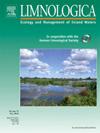Environmental preservation leads to greater beta diversity of periphytic algae in Amazonian streams
IF 2
4区 环境科学与生态学
Q2 LIMNOLOGY
引用次数: 0
Abstract
Changes in land use modify the structure of forests and the dynamics of streams. They cause changes in the chemical and physical environments, directly affecting the composition of the local aquatic biota. Our research sought to answer whether species composition is different between streams with different land uses; whether density is higher in locations with lower environmental integrity values; whether the richness and diversity of periphytic species are related to higher values of environmental integrity indices; and whether beta diversity is greater in streams in preserved areas. 18 streams were sampled in the Tapajós River basin, in a range of at least 100 km in the stretch that comprises the banks of the Amazon National Park and its surroundings, located in the southwest region of the State of Pará. Samples of periphytic algae were obtained from the Nymphaea amazonum Mart. & Zucc macrophyte. Our study demonstrated that streams located in preserved areas (national forest) differed environmentally from streams with agricultural land use and presented higher environmental integrity values. Species composition differed between different land uses. Environmental integrity had no effect on species diversity, richness and density. Beta diversity responded to different land uses, and the highest values were observed in streams from more intact environments. Our results showed that environmental variables had a greater influence on the structuring of the periphytic community than landscape variables. Preserved areas were important in environmental heterogeneity and in the formation of the structure of periphytic communities. Our study demonstrated that streams located in preserved areas differ from surrounding streams with different land uses, mainly because they present greater environmental integrity and greater variation in the beta diversity of periphytic algae.
环境保护导致亚马逊河流中周围植物藻类的β多样性增加
土地利用的变化改变了森林的结构和河流的动态。它们引起化学和物理环境的变化,直接影响当地水生生物群的组成。我们的研究试图回答物种组成是否在不同土地利用的溪流之间有所不同;环境完整性值较低的地点是否密度较高;周边植物物种的丰富度和多样性是否与较高的环境完整性指数有关;以及在保护区的溪流中beta多样性是否更大。在位于帕尔州西南地区的亚马逊国家公园及其周边地区,在Tapajós河流域至少100 公里的范围内对18条溪流进行了采样。从亚马逊若虫市场获得了周围生长藻类的样本。,调查和大型植物。研究表明,位于保护区(国家森林)的河流与农业用地的河流在环境上存在差异,具有更高的环境完整性值。不同土地利用方式的物种组成存在差异。环境完整性对物种多样性、丰富度和密度没有影响。β多样性对不同的土地利用方式有响应,在更完整的环境中观察到最高的值。结果表明,环境变量对周边植物群落结构的影响大于景观变量。保护区在环境异质性和周边植物群落结构的形成中起着重要作用。我们的研究表明,位于保护区的河流与周围不同土地利用的河流不同,主要是因为它们具有更大的环境完整性和更大的周围藻类多样性变化。
本文章由计算机程序翻译,如有差异,请以英文原文为准。
求助全文
约1分钟内获得全文
求助全文
来源期刊

Limnologica
环境科学-湖沼学
CiteScore
3.70
自引率
5.90%
发文量
64
审稿时长
3 months
期刊介绍:
Limnologica is a primary journal for limnologists, aquatic ecologists, freshwater biologists, restoration ecologists and ecotoxicologists working with freshwater habitats.
 求助内容:
求助内容: 应助结果提醒方式:
应助结果提醒方式:


